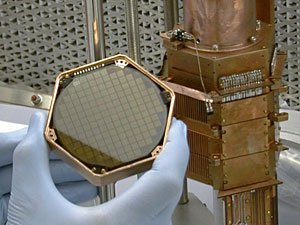A new form of matter? (general explanation)

Particles of invisible 'dark matter' may just have been detected
By Deane Morrison
A decades-long search for the invisible "dark matter" that gives shape to galaxies and forms the bulk of the Universe's mass may be over.
If confirmed, the finding will rank as a milestone in physics and take a big step toward completing the picture of the matter that composes our Universe.
Physicists at the University of Minnesota and 17 other institutions have recorded two interactions of subatomic particles whose signals look like those expected from particles of the elusive dark matter.
"But before you can declare a definitive discovery, you have to have confirmation from other experiments going on worldwide, as well as our own next-generation experiment," says University physics professor Priscilla Cushman. "There's about a one-in-four chance the signals are caused by ordinary interactions."
An enlightening talk
Oleg Kamaev, a postdoctoral CDMS researcher, will present a special seminar on the experiment at 2:30 p.m. Friday, December 18, in Room 435 Tate Laboratory of Physics, 116 Church St. S.E., on the Minneapolis campus.
Besides Cushman, University assistant professor Vuk Mandic and several graduate students and postdoctoral researchers are involved in the project.
A reclusive substance
Although dark matter accounts for some 80 percent of the mass in the Universe, it is invisible because it cannot absorb, reflect, or emit light. According to theory, it interacts extremely weakly with ordinary matter. Its existence was only inferred when it became apparent that the visible material in galaxies couldn't generate enough gravity to hold the galaxies together at the speeds they rotate.
A glance at an average galaxy shows a flat spiral of stars. But galaxies, including our own Milky Way, are actually spherical, because most of their mass is a ball of dark matter. Dark matter is believed to have provided the gravitational power that made normal matter coalesce into galaxies, and Earth sails through billions of these particles every second.
"There's so much indirect evidence for dark matter, it is hard not to expect to find it," says Cushman.
The signals in question came from the CDMS-II (Cryogenic Dark Matter Search) experiment, going on half a mile underground in northern Minnesota's Soudan mine, where it is shielded from cosmic rays that would confound the results. In a nutshell, the experiment recorded what may be particles of dark matter "bumping" the nucleus of an atom of germanium, producing a detectable vibration.
"This is a very exciting time for our field," says Mandic. "The coming decade will likely see the direct detection of dark matter, even if our experiment may have only seen a background fluctuation."
For a brief discussion of dark matter and the experiment, see Tracking the phantom.
